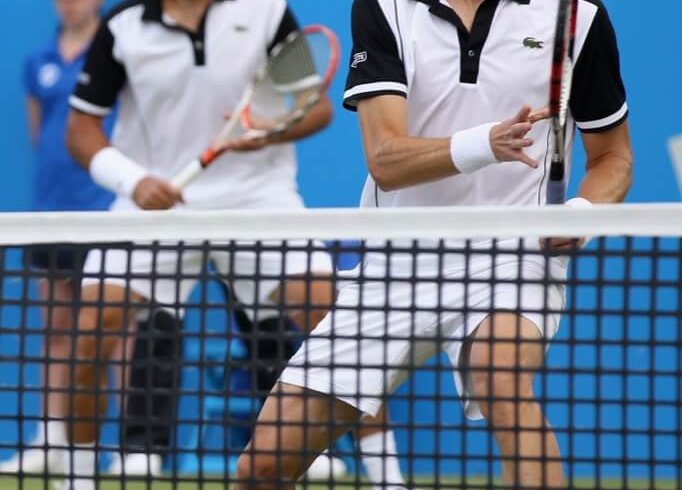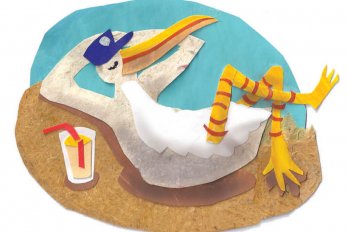Most canadians have heard the name Daniel Nestor at one time or another. They just have trouble placing him. Musician? Architect? Iron Chef? The average Canuck would have an easier time identifying a second-string Leafs player. It’s ironic, considering that while the Leafs annually give new meaning to the word “excremental,” thirty-seven-year-old Nestor is one of the world’s dominant tennis players. Routinely number one in the Association of Tennis Professionals rankings, the Toronto-bred lefty has won some seventy titles during his career, seven of them Grand Slams (most recently the 2010 French Open), and earned a gold medal at the 2000 Olympics in Sydney. Having played for nearly twenty years, he is poised to become the first ATP player to break the 800-wins mark. He has been named Tennis Canada’s male player of the year seven times, and in 2009 bagged over $1 million in prize money.
Oh yeah, did we mention that he plays doubles?
“I’m not complaining,” Nestor says philosophically about his game’s obscurity. “I’ve had a good career.” That’s an understatement. A shy kid, he first picked up a racquet at age eight and found solace whacking tennis balls against the school wall. He turned pro in 1992, back when Johnny Mac was still throwing tantrums professionally. A naturally aggressive yet cool-headed competitor, Nestor excelled at serve-and-volley: “It was all or nothing; if I served big, I could beat anyone.” He registered victories over titans such as Stefan Edberg and was ranked as high as fifty-eighth in the world. But in 2002, after a difficult recovery from shoulder surgery, he changed course, deciding to devote his energy to doubles. “It’s much easier on the body,” he says.
Splitsville
A Chicago divorce lawyer sexes up the single life
Partnership has its benefits—support, security—but sometimes you have to drop the dead weight, right? Chicago law firm Corri Fetman & Associates, Ltd. thinks so. In 2007, it launched an ad campaign featuring a pair of lightly clothed, heavily tanned torsos alongside the slogan “Life’s short. Get a divorce.” The billboard, strategically placed on the “Viagra Triangle” corner of a ritzy Chicago district, generated controversy among onlookers, who felt it trivialized divorce and encouraged infidelity. Fetman, herself a divorcee, disagreed: “It promotes happiness and personal integrity,” she told abc News. It also promotes Fetman. Since the campaign launched, the forty-three-year-old has appeared in Playboy and penned an advice column for the magazine under the handle Lawyer of Love.
—Jennifer Marston
Easier on the body, yes, but much tougher on the profile. The sad truth is that being the world’s greatest doubles player is a little like being its finest stonemason. Unquestionable skill is involved, but it’s hard to tell if anybody outside the profession really cares. While there are a few legends—Calcutta-born doubles star Leander Paes is front page news in his home country, and the American Bryan brothers garner coverage in the US media—for the most part doubles gets lost in the sports pages. Blame marketing. Singles tennis glorifies the individual, while team sports such as hockey and basketball glorify group effort; both are easy to promote.
Doubles is another story. “This game is a lot like a marriage,” notes Nestor, who is married and has a young daughter. It takes trust, communication, and balance, but first, he says, “you have to find someone you are compatible with.” In his case, someone like Bahamian Mark Knowles, with whom he paired occasionally in the ’90s. It proved a phenomenal partnership; the right-handed Knowles had the quickness to complement Nestor’s big serve. By 2007, however, Nestor began to feel the duo was “growing stale” and made a switch, pairing up with Serbian right-hander Nenad Zimonjić. Most questioned his wisdom, but it has produced results. The duo has already won three Grand Slams, as many as Nestor recorded during his long partnership with Knowles—which makes Nestor the doubles equivalent of Mr. Right. Still, “it can be an emotional roller coaster,” he says. “There are arguments. There are growing pains. You can take each other for granted.”
Try selling Gatorade with that copy.
In 2006, the ATP altered the rules for doubles, in an attempt to shorten matches and thereby attract celebrity players who don’t want to jeopardize their singles play. The move worked, to a degree; regular matches tend not to run longer than ninety minutes, and now some top seeds, such as Rafael Nadal, play doubles at big events. The introduction of these players, however, is beginning to transform the unique style of play that makes doubles an engaging spectator sport. “The game is more about angles and precision,” says Nestor, “while singles is just pounding the ball from the baseline. But now you have guys in doubles serving and staying back—like Nadal. I’ve never seen a guy hit the ball like that.”
Whatever the fallout from the rule changes, Nestor plans on sticking around, and is already thinking ahead to the 2012 London Olympics (though he’ll have to find a new Canadian to pair with, since Sébastien Lareau, his gold medal partner, and Frédéric Niemeyer have both retired). If he lasts, Nestor will become one of the oldest players on the men’s tour. “I’ve been playing so long,” he says, “if I was a fan and I saw my name on the draw sheet I’d say, ‘Jesus Christ, can’t we get someone new? Do we have to watch him again? ’” Yet a field of savvy veterans may turn out to be doubles’ greatest strength and its real hope for better appreciation.
Some of the most memorable matches ever played were between upstart kids and grizzled veterans (think thirty-eight-year-old Jimmy Connors’ incredible five-set victory over twenty-four-year-old Aaron Krickstein at the 1991 US Open). In singles, though, those matches are a thing of the past. Roger Federer is now twenty-nine and already thought to have peaked. In doubles, experienced players still flourish, bringing with them moves and, more important, cunning that only decades on the court can foster. “I’m still learning,” confirms Nestor. “Tennis is ninety percent mental. I guess I’m a late bloomer.”
This appeared in the September 2010 issue.






